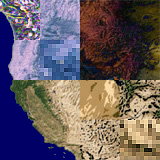
THE
DIGITAL CULTURES PROJECT:
A University of California
Multi-Campus Research Group
Director: William Warner,
UC Santa Barbara
| Discussion
Threads from "Interfacing Knowledge: New Paradigms for Computing in
the Humanities, the Arts, and the Social Sciences" (March 8-10, 2002) Compiled by William Warner |
A few apercu spoken
at our conference:
|
|
Thread 1: Interface transparency versus opacity; "user-friendliness'
versus alterity From the earliest session of this conference, a strong thread of
discussion developed around visualization. Transparency has strong
roots in Western epistemology and aesthetics, but so does a tradition
of mirroring and reflection, that emphasize not content and creators,
but process, users, and contexts. (Bolter) The transparency of the
interface may be an illusion (Ernst), but new technology is making
that illusion stronger (Manovich). The interface, by linking humans
and machines, may introduce an alternity or otherness more radical
than that expressed by mere visual opacity. We might grasp the alterity
of the technology behind the interface by considering writing as
a selfish gene (Siskin): the interface augments the human (rather
than merely accommodating it, with "user-friendliness"). Because
the analogy ascribes agency to a gene, such an analogy risks a form
of anthropomorphism.(Poster) However, this charge of anthropomorphism
assumes we know what the human is (Ernst). Question:
|
|
Thread 2: History and the interface; or, the charge of anachronism
Throughout this conference there was a debate about the usefulness
of the recourse to history to understand new media. Conversely,
new media might revise our our understanding of old media technologies.
No one at the conference embraced the logic of the "ancient" position:
truth must come in the forms that the greatest thinkers of the past
practiced or envisioned; no one (not even Alan Kay) adopted the
most iconoclastic "modern" stance: that modern science invents new
technologies for knowing that utterly surpass and outdate those
we have received from the past. However, the evocations of earlier
forms of knowing, when used to interpret new media, were constantly
open to the charge of anachronism. Thus it was asked, does elucidating
new technologies through recourse to history hide something? (Liu)
The strongest use of an old interface to invent a new one came in
the presentation of the Camillo project, "Know It All." (Meadow,
Sallis, and Dobbs) Sharp critique of this project came from the
perspective of modern design: wasn't adapting the 7X7 (curved) matrix
of a Renaissance project essentially arbitrary? (Lunenfeld) Does
this project blur the distinction between interface and data organization
(which is numerical rather than spatial; distributed on a network
rather than organized into a theater)? Why recapitulate an earlier
spatialization of knowledge? In rejoinder: the development of the
web suggests the cultural staying power of spatialization; networked
knowledge, through peer-to-peer file sharing, would allow the collaborative
sharing of individually structured data sets.
|
|
Thread 3: It's the technology stupid! Behind the interface
lurks the system (Siskin), simulation (Aarseth), mobility (Parks),
the temporal dimension (Ernst), interactive immersion (Morse), global
networking (Poster), visualization (Lunenfeld), the database from
which a sublime quantity of data pours (Liu), software code (Manovich)
…. If the concept of the "cultural interface" (Manovich) suggests
why the interface can never have done with history, why in both
its uses and forms the interface is embedded in a culture that has
momentum, then a number of the conference presentations insisted
that interfaces derive much of their meaning and force from the
new technologies that enable them. If our histories courts the danger
of domesticating new technologies by embedding them in the past,
then Espen Aaresth sought to defamiliarize the human-computer interface
by insisting that we account for what is "really" new in "new media."
His provisional answer was "simulation": the computer is coded to
act upon itself so it can simulate other things and processes. A
modification of this idea from the floor: the computer as "emulation
machine" since it never gives up being itself"(Manovich). Aarseth's
skeptical work with defining new media had the effect of many other
talks: of reminding us that behind the interface there are networks,
satellites, databases, new techniques of visualization, all bound
together by computers running code. In facing the machine we face
a ghost with a decaying face. (Ernst) Our thought about the interface
needs to calculate the effects of these hard and soft machines.
In her Saturday afternoon
conference overview, Rosemary Joyce took up the metaphor of the
"splice," introduced by Wolfgang Ernst, to suggest that the interface
is the point of separation and connection where person and machine
are linked. Invoking Bruno Latour, Joyce suggested that it is through
the interface that a network of humans and non-humans become linked
and act together. Life at the interface is necessarily hybrid, one
lived within a network of humans and non-humans. Questions:
|
|
Thread 4: Political,
social and aesthetic strategies of interface work: doing something
with it. Many of conference talks
alerted us to the political stakes of how we interface with these
technologies, and offered strategies for avoiding the occlusions
that can proliferate at the interface. For example, what are the
effects of the software design in the background of any database
search we perform? (Manovich, Bowker, Liu) The topologies used to
represent relations among data and diverse objects (for example
in 'a tree of life') have political consequences worth calculating.
Some computer databases deploy regimes of implosion (like gene banks)
that are in tension with regimes of particularity (eco-system survival).[Bowker]
Making visible what is usually hidden can become a useful strategy.
Questions:
|